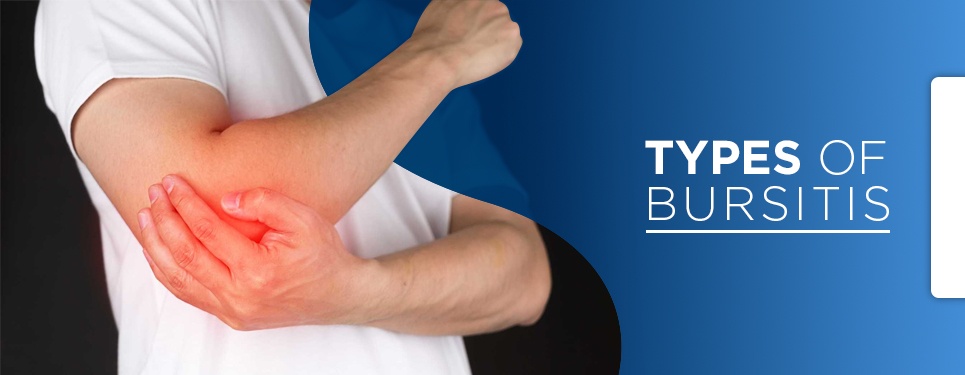
Bursitis is a painful ailment affecting your joints. Fluid-filled sacs known as bursae act as a cushion between your tendons, bones, muscles and joints. Inflammation of these sacs is called bursitis. It’s a fairly common condition, but many individuals treat inflammation of the bursa at home and don’t see their doctor, so it’s difficult to know exactly how common it really is.
While bursitis can occur in any area of your body where you have bursae, there are a few specific types of bursitis, which we cover in this article. You’ll also learn the causes and symptoms of each type, treatment options and how to prevent bursitis, which may include gentle stretching before exercising.
Hip Bursitis – What Is It?
Hip bursitis, also called trochanteric bursitis, causes pain on the outside of the hip joint. Frequently, individuals worry the symptoms they experience are those of hip arthritis, but hip bursitis-related pain is felt consistently on the outside of your hip, while hip arthritis is usually felt in your thigh, groin or buttocks.
Hip bursitis usually hurts when you place direct pressure on your hip and is frequently an issue when you sleep at night on your side. It will usually improve with simple treatment like ice, rest, physical therapy and injections.
Causes of Hip Bursitis
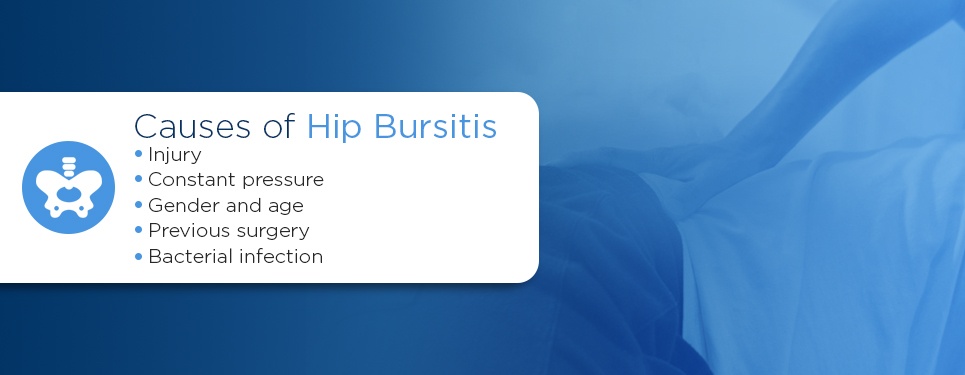
There are many known hip bursitis causes, ranging from mild to severe. Some include:
- Injury: Actions like falling on your hips on hard surfaces could cause your bursa to become inflamed and fill with blood. This is called traumatic bursitis.
- Constant pressure: Repetitive pressure on your hip can lead to your bursa becoming inflamed over time, even small amounts of pressure. Activities related to hip bursitis include running in marathons or riding bicycles for a long time.
- Gender and age: Those in their middle or senior years have an increased risk of hip bursitis. Also, women seem to develop it more than men.
- Previous surgery: If you’ve had a surgical procedure performed on your hip in the past, it could increase your likelihood of developing bursitis.
- Bacterial infection: Bacteria can get into your bloodstream, infecting your hip bursa if you have an open skin wound. When this occurs, you develop septic bursitis, which can be deadly if you don’t have it treated immediately.
Some pre-existing conditions can cause also the development of hip bursitis, including:
- Unequal leg length
- Weak hip muscles
- Osteoarthritis
- Spinal curvature or scoliosis
- Rheumatoid arthritis (RA)
Symptoms of Hip Bursitis
Pain at the point of your hip is the primary symptom of trochanteric bursitis. This pain typically extends to the outside of your thigh area. It can be intense and sharp in the early stages and then spread across a bigger area of your hip and ache in later stages. You might also experience warmth and swelling around the affected area. Your bursa could become thick over time, making the swelling worse and causing weakened muscles and limited movement in the area.
How to Prevent Hip Bursitis
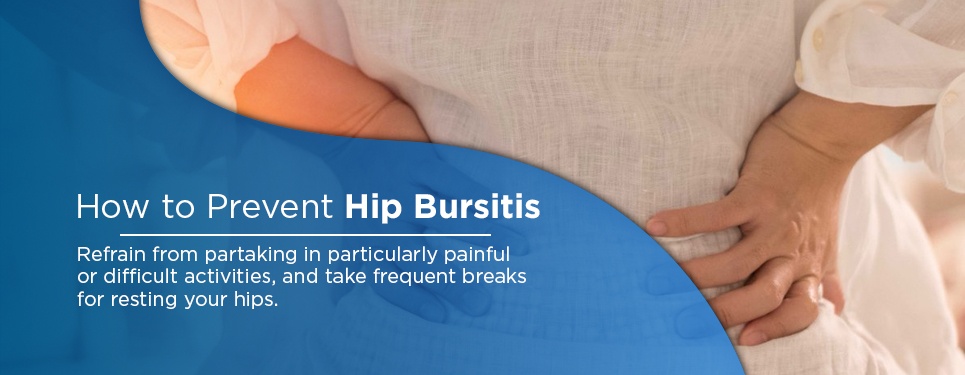
You can prevent bursitis by not placing a lot of strain on your hips. Refrain from partaking in particularly painful or difficult activities, and take frequent breaks for resting your hips. Remember to warm your muscles up when you exercise and stretch to prevent injury. Lose weight if you’re overweight, which can help decrease joint pressure, including your hips.
Knee Bursitis – What Is It?
Knee bursitis is where you have inflammation of your bursa located close to your knee joint. Bursae decrease pressure and friction points between your bones and muscles, tendons and skin close to your joints. Any of your knee bursa can become inflamed, but knee bursitis often occurs on the inner side of the knee below your joint or over your kneecap.
Bursitis impacting the knee is in some cases is called “housemaid’s knee” or “clergyman’s knee.”
Causes of Knee Bursitis
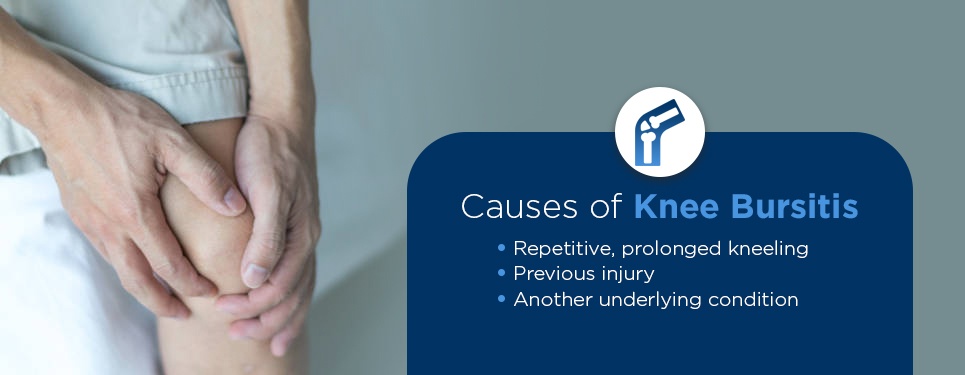
A few risk factors make some individuals more likely to develop bursitis of the knee. These include:
- Repetitive, prolonged kneeling: Frequent “mini-traumas” can cause bursitis and cause the same issues as one more severe trauma. If you kneel a lot, such as if you install carpets, you could develop knee bursitis.
- Previous injury: A knee trauma can damage your prepatellar bursa, causing its lining to become inflamed and it to fill with blood. While your body reabsorbs the blood, your bursa lining could stay inflamed and cause your knee bursitis symptoms.
- Another underlying condition: Another condition could cause your prepatellar bursa to become inflamed, such as rheumatoid arthritis, knee osteoarthritis, pseudogout or gout. In these instances, your knee bursitis treatment will need to accompany the underlying condition treatment.
Some individuals with knee bursitis develop septic bursitis where their prepatellar bursa becomes infected. Septic bursitis occurs more frequently during the summer months. You can develop an infection that reaches your bursa through a puncture, cut or insect bite. Sometimes you can develop septic bursitis without a noticeable scrape or cut and the root cause is unknown.
Certain medications and health conditions which suppress your immune system could make you more susceptible to septic bursitis. For instance, you could have a higher risk of developing septic bursitis if you have:
- Lupus
- Cancer
- Chronic obstructive pulmonary disease (COPD)
- Alcoholism
- Diabetes
- HIV/AIDS
Symptoms of Knee Bursitis
Symptoms and signs of knee bursitis vary and depend on the affected bursa and what the cause of the inflammation is. Generally, the affected part of your knee may feel tender, swollen and warm when you apply pressure on it. You may experience pain when you move or when resting.
How to Prevent Knee Bursitis
Prevention of knee bursitis consists of:
- Take breaks: If you’re on your knees for extended periods, take regular breaks to rest your knees and stretch your legs.
- Wear kneepads: If you participate in sports or work on your knees that place your knees at risk, protect your knees by using cushioned padding.
- Maintain a healthy weight: This could help relieve the pressure off your knee joint.
- Avoid excessive squatting: Repetitious or excessive bending of your knees increases the force on the joints of your knee.
Shoulder Bursitis – What Is It?
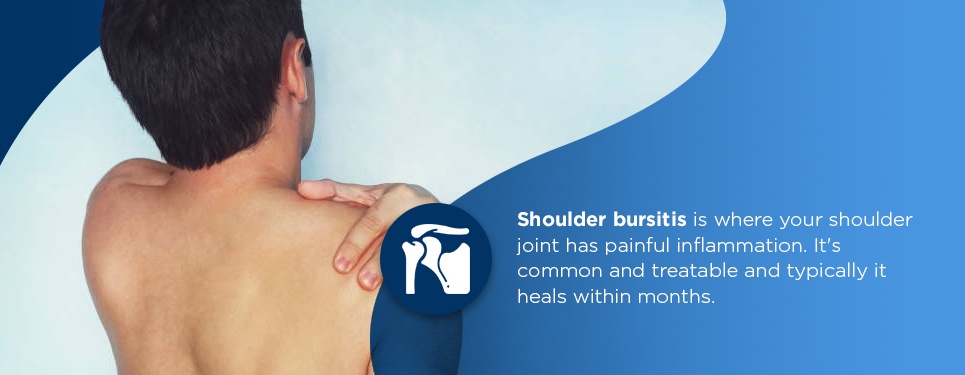
Shoulder bursitis is where your shoulder joint has painful inflammation. It’s common and treatable and typically it heals within months. Gentle exercises and rest could speed up recovery. When your shoulder bursa becomes irritated, it becomes inflamed, growing in size. This causes you to have less shoulder space for tendons and muscles to move around, which could cause pain and a loss of movement and pain in your shoulder.
Causes of Shoulder Bursitis
Shoulder bursitis can have more than one cause. Of the possible causes listed here, overuse and injuries are the most common. Causes include:
- Shoulder trauma or injury: Banging your shoulder or falling on a hard surface could cause your bursa’s lining to become inflamed and the bursa to fill with blood. Again, while your body reabsorbs the blood, the lining could remain inflamed and cause bursitis symptoms.
- Age: Although anyone of any age can develop shoulder bursitis, advanced age will increase your chances.
- Poor posture: If you tend to hunch your shoulders a lot, you’re reducing the space between your glenohumeral (shoulder) and acromion (top bony part on your shoulder) joints, which makes it more likely you will irritate or squeeze the soft tissue in between.
- Calcium deposits or bone spurs: Bone spurs, or osteophytes, growing on your acromion’s underside can irritate your bursae and other soft tissue of your shoulder. Calcium deposits can also cause irritation.
Like with knee bursitis, frequent “mini-traumas,” which could cause the same issues as one more severe trauma, could cause shoulder bursitis. If you repeatedly lift your arms overhead in sports or at work, you’re more susceptible to developing shoulder bursitis with time. You have a higher risk of shoulder bursitis if you’re a:
- Tennis player
- Painter
- Baseball pitcher
- Wallpaper hanger
- Swimmer
Symptoms of Shoulder Bursitis
Primary symptoms of shoulder bursitis are:
- Pain when you touch your shoulder
- Pain around the tip or outside of your shoulder
- Redness and swelling around your shoulder
- Decreased range of movement in your shoulder joint
- Shoulder pain when you raise your arm, as when washing your hair or reaching shelves
You may experience worsened pain at night, particularly when you lie on the affected shoulder. It could also become worse after you keep your shoulder still for a while. If you’re also experiencing a fever with these symptoms, you could have septic bursitis and need to see your doctor right away.
How to Prevent Shoulder Bursitis
The key to preventing shoulder bursitis is to reduce strain on your shoulder joint. You could prevent shoulder bursitis with the following strategies:
- Using gentle exercises to strengthen your shoulder muscles
- Stretching and warming your shoulder up before you exercise or use your shoulder joint repeatedly
- Taking breaks often when you use your shoulder repeatedly
- Building up slowly when you start a new activity that puts strain on your shoulder
- Improving your posture to reduce joint pressure and keep your shoulder muscles active
Elbow Bursitis – What Is It?
You get elbow bursitis in your olecranon bursa, a fluid-filled sac located at the bony tip of your elbow. Usually, your olecranon bursa is flat, but if it becomes inflamed or irritated, you could have more fluid accumulate in your bursa, causing bursitis.
Causes of Elbow Bursitis
There are a few reasons for elbow bursitis. These are:
- Too much pressure: If you lean your elbow for a long time against a hard surface, it could irritate your bursa. Air-conditioning technicians, plumbers and others often work on their elbows and have a greater risk of elbow bursitis.
- Trauma: If you hit your elbow, fall on top of it or experience some other hard blow to your elbow, it could cause your bursa to swell.
- Other conditions: If you’re dealing with another condition like rheumatoid arthritis or kidney failure where you require dialysis, your chances of elbow bursitis increase.
Symptoms of Elbow Bursitis
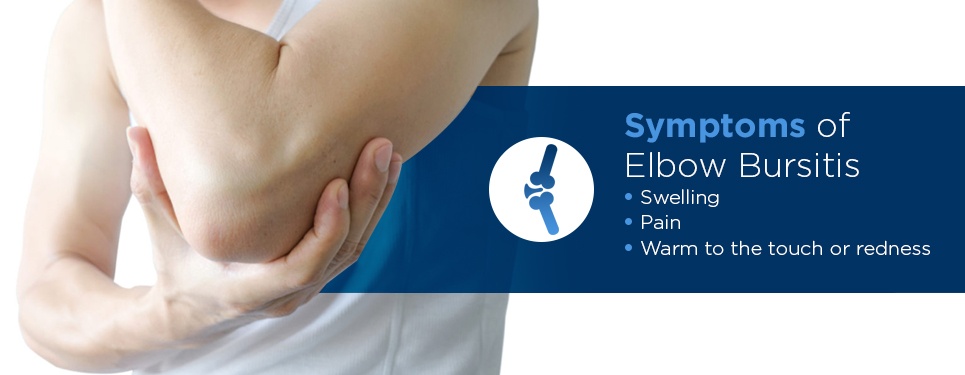
Symptoms may include:
- Swelling: Your first symptom of this condition will likely be swelling. You have loose skin on the back of your elbow, you may not notice a small amount of swelling right away.
- Pain: As this skin continues to swell, your bursa starts stretching, causing pain. Bending your elbow or direct pressure on it can worsen the pain. If the swelling grows large enough, it could cause elbow motion restriction.
- Warm to the touch or redness: If your bursa becomes infected, the skin will become warm and red. If you don’t have the infection treated right away, it could spread to other parts of your arm or even move into your bloodstream, causing you to become seriously ill.
How to Prevent Elbow Bursitis
Not all types of bursitis are preventable, but you could reduce the severity of it. You could also decrease your risk of flare-ups in the future.
Reduce the stress you place on the joint and avoid lifting heavy things. Muscle building and exercising could help prevent injury in the future.
Achilles Tendon Bursitis – What Is It?
Achilles bursitis, also called retrocalcaneal bursitis, is common in athletes. Your retrocalcaneal bursa lies between your calcaneus (heel bone) and your Achilles tendon. When you have repetitive trauma, it can cause bursa inflammation, which often gets confused with Achilles tendonitis.
Causes of Achilles Tendon Bursitis
There are several causes of Achilles tendon bursitis:
- Overuse: The most common cause of Achilles tendon bursitis is overusing your ankle and heel area. Not warming up before exercise properly or a quick increase in physical activity could both cause this.
- Wearing improper shoes: Walking in high heels or exercising in poor-fitting shoes could cause Achilles tendon bursitis. If you currently have bursitis, wearing these kinds of shoes could make it worse.
- Arthritis: Sometimes, arthritis could cause the condition.
Symptoms of Achilles Tendon Bursitis
Heel pain is the main symptom of Achilles tendon bursitis. You may only experience the pain when you apply pressure on your heel.
Other symptoms might include:
- Pain when you lean back on your heels
- Swelling surrounding the back of your heel area
- Loss of movement
- Stiffness
- Pain in your calf muscles when you walk or run
- Shoes becoming uncomfortable
- Warm or red skin on the back of your heel
- Crackling sound when you flex your foot
How to Prevent Achilles Tendon Bursitis
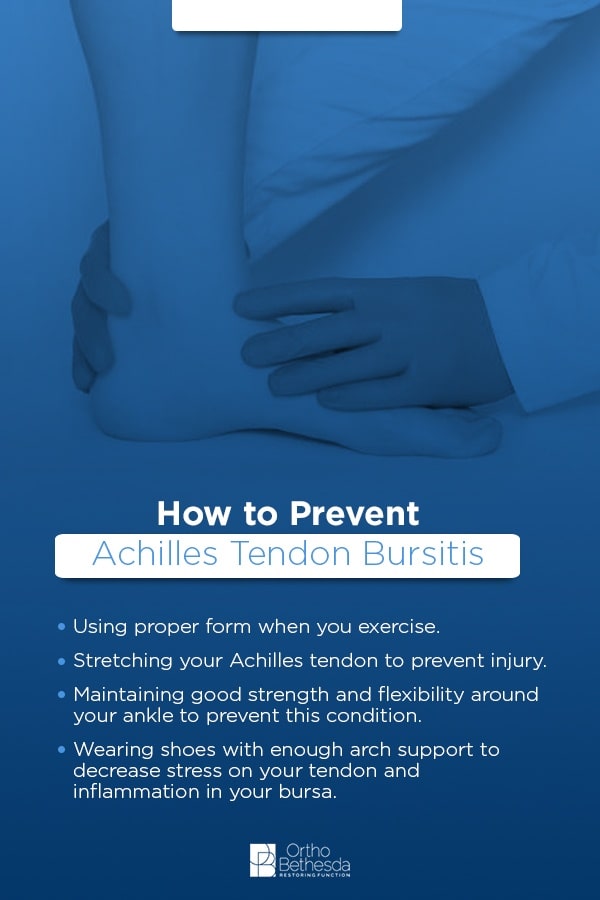
You could prevent this problem by:
- Using proper form when you exercise.
- Stretching your Achilles tendon to prevent injury.
- Maintaining good strength and flexibility around your ankle to prevent this condition.
- Wearing shoes with enough arch support to decrease stress on your tendon and inflammation in your bursa.
Iliopsoas Bursitis – What Is It?
Iliopsoas bursitis is inflammation of the bursa under the iliopsoas muscles, which connect the femur to the spine and are the strongest hip flexors. This is different from hip bursitis, which is inflammation of the bursa on the outside of the femur. Iliopsoas bursitis could cause limited range of motion and pain in your hip joint. It often develops from overuse in those who regularly exercise or athletes.
Causes of Iliopsoas Bursitis
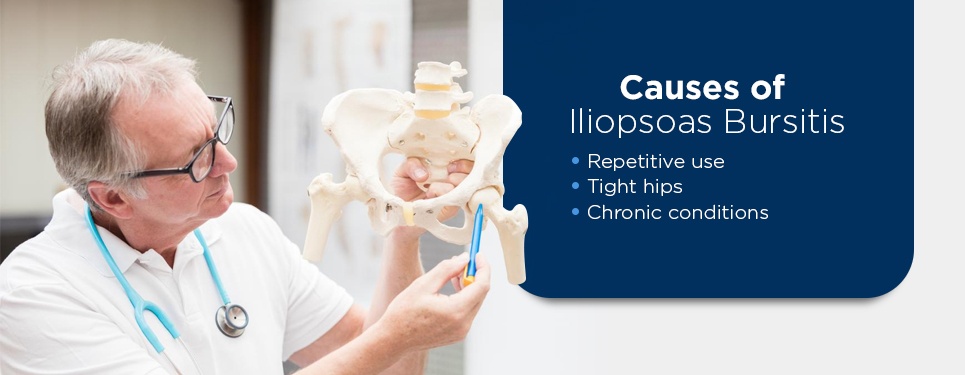
A few things can cause iliopsoas bursitis:
- Repetitive use: Physically active individuals and athletes have a higher risk than those who are sedentary. Skiers, swimmers and runners all have a risk of developing iliopsoas bursitis.
- Tight hips: If you have tight hips, you could develop this condition. Tight hips place additional pressure on your joints, ligaments and muscles, causing friction, leading to this condition.
- Chronic conditions: Some chronic conditions like osteoarthritis and rheumatoid arthritis could increase your risk. They both could cause excess friction in your hips, leading to iliopsoas bursitis.
Symptoms of Iliopsoas Bursitis
Depending on how severe the swelling is, you could experience pain in the front of your hip and radiating down your leg. It could also radiate towards your buttocks.
Also, you could experience stiffness in the morning. This stiffness often subsides throughout the day, but you could experience pain when you:
- Exercise
- Walk up and down the stairs
- Extend or lift one or both of your legs
- Stand up from a sitting position
It’s not uncommon for the discomfort and pain to become more severe over time.
How to Prevent Iliopsoas Bursitis
Exercise and stretching could help prevent this condition. One of the main causes is rubbing and friction potentially occurring when your hips are too tight. You can alleviate the tightness with stretching.
Back Bursitis – What Is It?
Certain spine disorders like arthritis, scoliosis and leg length discrepancy could all increase your risk of bursitis.
Scapulothoracic bursitis impacts your upper back between your ribs and shoulder blades and could cause a popping sensation or pain. You can worsen the pain by doing push ups or reaching your arms overhead.
Causes of Back Bursitis
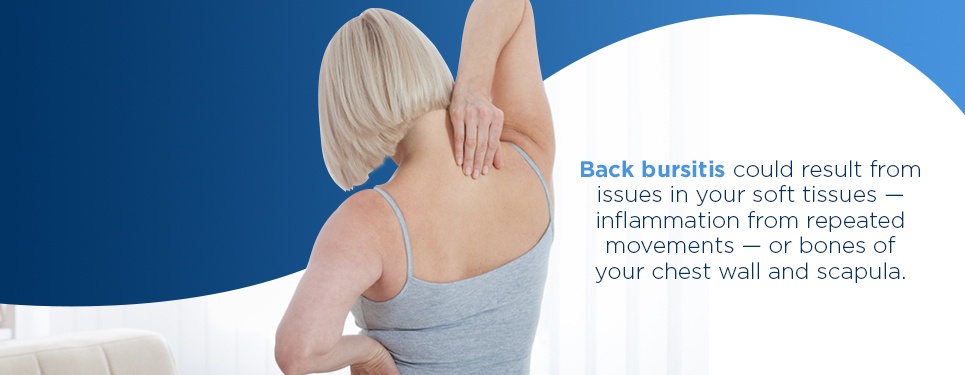
Back bursitis could result from issues in your soft tissues — inflammation from repeated movements — or bones of your chest wall and scapula. In some cases, your muscles under your scapula shrink from inactivity or weakness, and this leaves your scapula bone closer to your rib cage. This leads to friction from your bones rubbing and bumping together when you move, which causes back bursitis to develop.
Other possible causes are:
- Abnormal bumps, ledges or curves in the upper edge of your scapula
- Injury or trauma
- Changes in contour or alignment of your bones of your scapulothoracic joints
- Poor scapular mobility
- Inflammatory conditions like rheumatoid arthritis
Symptoms of Back Bursitis
Some symptoms you may experience with back bursitis are:
- Grating, grinding and snapping sensation in your shoulder blade
- Aches and pains in your shoulder area
- Stiffness or tenderness
- A possible lump from a scapula bone growth
- Shoulder instability
- Tissue in the impacted area often feels thick
- Swelling in your shoulder area
How to Prevent Back Bursitis
Perform range-of-motion exercises each day for preventing stiffness.
Treatment for Bursitis
Bursitis treatment options include:
- Rest and splints: Muscle overuse causes many soft tissue conditions, therefore the first line of treatment might include avoiding certain activity and resting the painful area for a while. Braces, slings or splints allow the area to rest until your pain eases.
- Cold and hot therapy: A cold compress could help decrease initial pain and swelling. It’s typically most effective during your first couple of days after overuse, swelling or injury begins. Moist or dry heat might be more helpful than cold therapy for chronic pain.
- Medication: Your doctor might recommend an over-the-counter (OTC) pain reliever like ibuprofen or acetaminophen. They might prescribe you a stronger pain reliever for more severe symptoms like prescription-strength nonsteroidal anti-inflammatory drugs (NSAIDs), which also help with swelling.
- Corticosteroids injections: These are strong anti-inflammatory medications your doctor injects directly into your joint.
Your doctor may also recommend physical therapy. A physical therapist could provide you with:
- Joint or soft tissue mobilization via manual therapy
- Cold or hot treatments
- Laser and water therapy
- Ultrasound
- Analysis of walking and posture
- An individualized exercise program
- Pressure-relieving devices or orthodontics for your legs and arms
- Education on appropriate activities to allow healing
Surgery is rarely required for treating bursitis. It’s used only when the conservative treatments fail. If you do require surgery, it’s a fairly simple procedure. Your doctor will remove the inflamed bursa. Many joints can still function regularly without the bursa. Typically, the surgery doesn’t require you to stay for a long visit in the hospital and your recovery period should be short.
Contact OrthoBethesda for Your Bursitis Treatment Needs
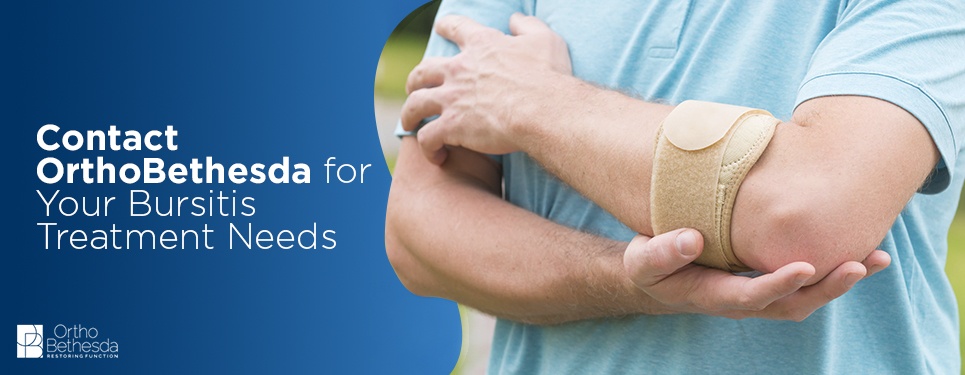
Don’t continue to endure the pain of bursitis at home. Call us today at (301) 530-1010 to schedule an appointment with an orthopedic surgeon at OrthoBethesda. You can also request an appointment online. We’ll help you treat you bursitis, and show you how to prevent it from reoccurring.
Related Content
- Arthritis vs. Arthrosis
- Common Types of Arthritis Explained
- Consequences of Delaying Medical and Surgical Care
- Winter Injury Prevention Guide
- Inpatient Surgery vs. Outpatient Surgery
- Why Your Joints Are Cracking
- What Does an Orthopedic Doctor Do?
- How to Prevent Osteoporosis
- Types of Common Outpatient Surgeries
- What to Wear and What Not to Wear During Surgery
